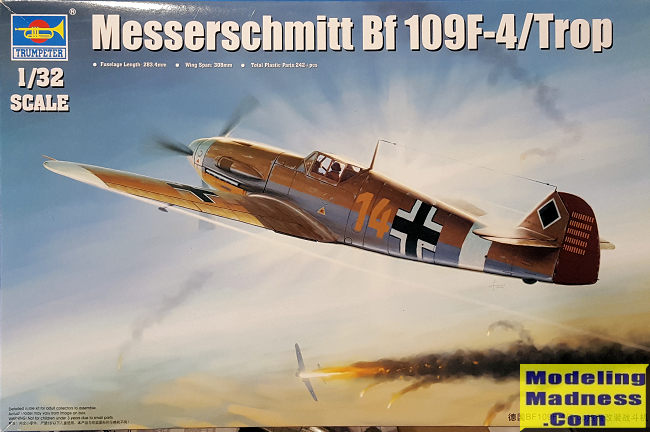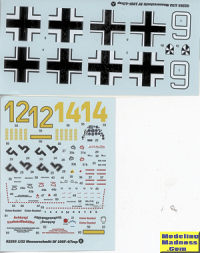
Trumpeter 1/32 Bf-109F-4/trop
| KIT #: | 02293 |
| PRICE: | $25.00 on sale |
| DECALS: | Three options |
| REVIEWER: | Scott Van Aken |
| NOTES: |

| HISTORY |
The 1,350 PS (1,332 hp, 993 kW) DB 601 E was used in the F-3 and F-4 model together with a VDM 9-12010 propeller with broader blades for improved altitude performance. The DB 601 E was initially restricted to 1,200 PS (1,184 hp, 883 kW) at 2,500 rpm; however, the full rating of 1,350 PS at 2,500 rpm was cleared for service use by February 1942. The DB 601 E ran on standard 87 octane "B-4" aviation fuel, despite its increased performance; while the earlier DB 601 N required 100 octane "C-3" fuel.
Only 15 examples of the F-3 are believed to have been produced by Messerschmitt Regensburg between October 1940 and January 1941. Like the F-1, the F-3 was armed with the 20 mm MG-FF/M and two 7.92 mm (.312 in) MG 17s.
From the F-4 onward, the new 20 mm Mauser MG 151/20 with 200 rounds was used as the Motorkanone. The first F-4s reached frontline units in June 1941. Production lasted exactly a year between May 1941 and May 1942, with 1,841 of all F-4 variants produced. Some of the later models were capable of mounting two 20 mm MG 151/20 cannons under the wing in faired gondolas with 135 rpg. These were designated F-4/R1 and 240 of them were produced by WNF in the first quarter of 1942. This optional additional armament was standardized as field kit for later G and K series. A special high-altitude variant, the F-4/Z featuring GM-1 boost, was also built with a production run of 544 in the first quarter of 1942 and saw extensive use. Finally, the Erla factory produced 576 tropicalized F-4 trop in the first half of 1942.
With its initial engine rating of 1,200 PS, the maximum speed of the F-4 (and F-3) was 635 km/h (394 mph) at rated altitude; and with the clearance of the full rating of 1,350 PS, maximum speed increased to 659 km/h (410 mph) at 6,200 m (20,341 ft).
| THE KIT |
Putting together the fuselage means that you attach the engine cowling covers. There are no props to hold these up if you want to display all those parts you put into the engine so you'll need to fabricate those. Modelers who want to leave these covers closed can skip putting a lot of parts on the engine, though the block is needed to hold the guns and exhaust.
Rudder and elevators are separate but tabbed to only fit in the neutral position, just like the ailerons. Quite a few of the small p.e. bits are used on the canopy and surround. The area behind the seat has a p.e. cover held in place by a two piece p.e. strap. The head armor is also photo etch. There is no hinge area shown to keep the canopy open, but a resourceful modeler will be able to devise something.
 With the fuselage and wings completed, they are
joined. There is a rack and drop tank. The tank strap is photo etch and
unbelievably, the little mounting points on the tank are also separate. The
last things to be attached are the landing gear, the build up lower cowling
piece (which does have a p.e. radiator screen), and the gun gondolas (if you are
using them). Most 109F aircraft did not use these wing cannon as they adversely
affected the handling of the aircraft.
With the fuselage and wings completed, they are
joined. There is a rack and drop tank. The tank strap is photo etch and
unbelievably, the little mounting points on the tank are also separate. The
last things to be attached are the landing gear, the build up lower cowling
piece (which does have a p.e. radiator screen), and the gun gondolas (if you are
using them). Most 109F aircraft did not use these wing cannon as they adversely
affected the handling of the aircraft.
Instructions are standard landscape type used by Trumpeter. Color info is provided during the build using Gunze references. Markings are provided for three desert camo aircraft in RLM 79 over RLM 78. One is the box art plane of Marseilles, which is pretty much expected. The other two adds RLM 80 to the scheme making for a much more interesting camouflage. Decals are nicely printed with split swastikas. No unit information is provided for any of the options.
| CONCLUSIONS |
So there you have it. Another nice looking kit with lots of detail and options that the earlier offerings did not provide. Are they better than the Hasegawa kits? I don't know but I do know that they are more easily available and not as expensive, which surely counts for something.
| REFERENCES |
https://en.wikipedia.org/wiki/Messerschmitt_Bf_109_variants#F-3,_F-4,_F-5,_F-6
January 2021
Copyright ModelingMadness.com. All rights reserved.
If you would like your product reviewed fairly and fairly quickly, please contact the editor or see other details in the Note to Contributors.
Back to the Main Page Back to the Review Index Page Back to the Previews Index Page